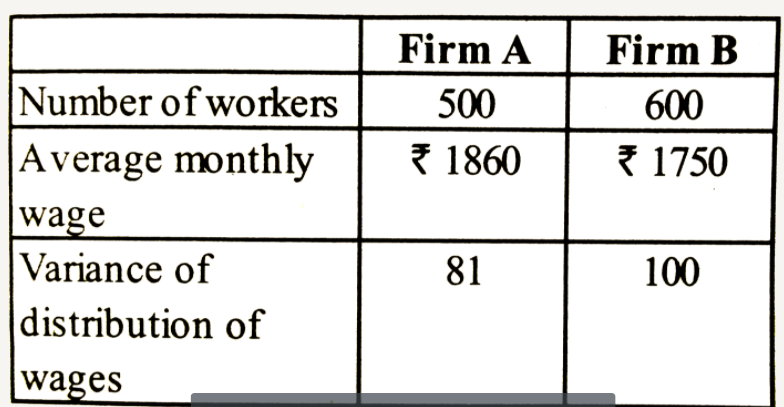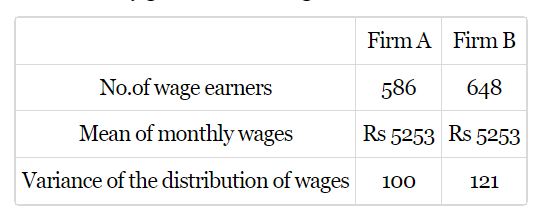An analysis of monthly wages paid to workers in two firms A and B, belonging
to the same industry, gives the following results:
Firm A
Firm B
No. of wages earners
586
648
Mean of monthly wages
Rs. 5253
Rs. 5253
Variance of the distribution of wages
100
121
( i ) Which firm A or B pays to larger mount as monthly wages?
(ii) Which firm A or B shows greater variability in individual wages?
The correct Answer is:firm B has greater variability in the individual wages
\begin{aligned} &(i) Number of wage earner in firm A=586\\ &Mean of monthly wage of firm A=\operatorname{Rs} 5253\\ &Mean of monthly age of firm A=\frac{\text { Total amount paid }}{\text { No. of wage eamers in firm } A}\\ &5253=\frac{\text { Total amount paid }}{586}\\ &Total amount paid by Firm A=5253 \times 586\\ &Number of wage earner in firm B=648\\ &Mean of monthly wage of firm B = Rs5 5253\\ &Mean of monthly age of firm B=\frac{\text { Total amount paid }}{\text { No. of wage eamers in firm } B}\\ &5253=\frac{\text { Total amount paid }}{648}\\ &Total amount paid by Firm B=5253 \times 648\\ &Clearly, firm B paid larger amount as monthly wage.\\ &(ii) Variance of the distribution of wages in firm A\left(\sigma_{1}^{2}\right)=100\\ &\therefore Standard deviation of the distribution of wages in firm &\mathrm{A}\left(\sigma_{1}\right)=\sqrt{100}=10\\ &Variance of the distribution of wages in firm B\left(\sigma_{1}^{2}\right)=121\\ &\therefore Standard deviation of the distribution of wages in firm B\left(\sigma_{2}\right)=\sqrt{121}=11\\ &The mean of monthly wages of both the firms is same i.e.5253. So, the firm with greater standard deviation will have more variability.\\ &Thus firm B has greater variability in the individual wages\\ \end{aligned}
Topper's Solved these Questions
Similar Questions
An analysis of monthly wages paid to workers in two firms A and B, belonging to the same industry, gives the following results: Firm A Firm B No. of wages earners 586 648 Mean of monthly wages Rs. 5253 Rs. 5253 Variance of the distribution of wages 100 121
( i ) Which firm A or B pays to larger mount as monthly wages?
(ii) Which firm A or B shows greater variability in individual wages?
View SolutionAn analysis of monthly wages paid to workers in two firms A and B, belonging to the same industry, gives the following result
(i) Which firm A or B pays larger amount as monthly wages?
(ii) Which firm, A or B, show greater variability in individual wages?
View Solution
Knowledge Check
Answer the questions on the basis of the information given below.
Venkat, a stockbroker, invested a part of his money in the stock of four companies A, B, C and D. Each of these companies belonged to different industries, viz, Cement, Information Technology (IT), Auto and Steel, in no particular order. At the time of investment, the price of each stock was Rs. 100. Venkat purchased only one stock of each of these companies. He was expecting returns of 20%, 10%, 30% and 40% from the stock of companies A, B, C and D, respectively. Returns are defined as the change in the value of the stock after one year, expressed as a percentage of the initial value. During the year, two of these companies announced extraordinarily good results. One of these two companies belonged to the Cement or the IT industry, while the other one belonged to either the Steel or the Auto industry. As a result, the returns on the stocks of these two companies were higher than the initially expected returns. For the company belonging to the Cement or the IT industry with extraordinarily good results, the returns were twice that of the initially expected returns. For the company belonging to the Steel or the Auto industry, the returns on announcement of extraordinarily the returns were twice that of the initially expected returns. For the company belonging to the Steel or the Auto industry, the returns on announcement of extraordinarily good results were only one and a half times that of the initially expected returns. For the remaining two companies. Which do not announce extraordinarily good results, the returns realized during the year were the same as initially expected.
If Company C belonged to the Cement or the IT industry and did announce extraordinarily good results, then which of these statement (s) would necessarily be true ?
I. Venkat earned not more than 36.25% return on average.
II. Venkat earned not less than 33.75% return on average.
III. If Venkatearned 33.75% return on average. Company A announced extraordinarily good results.
IV. If Venkatearned 33.75% return on average. Company B belonged either to Auto or to Steel Industry.AI and II onlyBII and IV onlyCII and III onlyDIII and IV onlyAnswer the questions on the basis of the information given below.
Venkat, a stockbroker, invested a part of his money in the stock of four companies A, B, C and D. Each of these companies belonged to different industries, viz, Cement, Information Technology (IT), Auto and Steel, in no particular order. At the time of investment, the price of each stock was Rs. 100. Venkat purchased only one stock of each of these companies. He was expecting returns of 20%, 10%, 30% and 40% from the stock of companies A, B, C and D, respectively. Returns are defined as the change in the value of the stock after one year, expressed as a percentage of the initial value. During the year, two of these companies announced extraordinarily good results. One of these two companies belonged to the Cement or the IT industry, while the other one belonged to either the Steel or the Auto industry. As a result, the returns on the stocks of these two companies were higher than the initially expected returns. For the company belonging to the Cement or the IT industry with extraordinarily good results, the returns were twice that of the initially expected returns. For the company belonging to the Steel or the Auto industry, the returns on announcement of extraordinarily the returns were twice that of the initially expected returns. For the company belonging to the Steel or the Auto industry, the returns on announcement of extraordinarily good results were only one and a half times that of the initially expected returns. For the remaining two companies. Which do not announce extraordinarily good results, the returns realized during the year were the same as initially expected.
If Venkat earned a 38.75% return on average during the year, then which of these statement(s) would necessarily be true?
I. Company C belonged either to Auto or to Steel industry.
II. Company D belonged either to Auto or to Steel Industry
III. Company A annouced extraordinarily good resuls.
IV. Company B did announce extraordinarily good results.AI and II onlyBII and III onlyCI and IV onlyDII and IV only
An analysis of the weekly wages paid to workers in two firms A and B, belonging to the same industry gives the following results; Firm A Firm B No. of wages earners 586 648 Average weekly wages Rs. 52.5 Rs. 47.5 Distribution of wages 100 121
(i) Which firm A or B pays out larger amount as weekly wages?
(ii) Which firm A or B has greater variability in individual wages?
View SolutionAn analysis of monthly wages paid to workers intwo firms A and B, belonging to the same industry, gives the following results:

(i) Which firm A or B pays larger amount as monthly wages?
(ii) Which firm A or B shows greater variability in individual wages?
View SolutionAn alalysis of monthly wages paid to the workers in two firms A and B belonging to the same industry the following result:

The average of monthly wages and variance of distribution of wages of all workers in the firms A and B taken together are
View SolutionTwo plants A and B of a factory show following results about the number of workers and the wages paid to them. Plant A Plant B No. of workers 5000 6000 Average monthly wages Rs. 2500 Rs. 2500 Variance of distribution of wages 81 100 In which plant A or B is there greater variability in individual wages?
View SolutionTwo plants A and B of a factory show following results about the number of workers and the wages paid to them.

In which plant, A or B is there greater variability in individual wages?
View SolutionWhich one of the following is the fixed cost for a firm?
(i) Rent paid in advance for 3 months.
(ii) Hourly wage to be paid to labour every month.
View Solution

